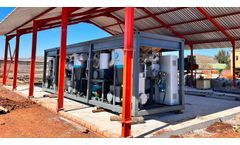Gasification System Articles & Analysis
34 articles found
Introduction Syngas, or synthesis gas, is a vital component in various industrial processes, serving as a fuel source and a raw material for chemical synthesis. It is primarily used in power generation, chemical production, and fuel manufacturing. Accurate measurement of syngas is critical to ensuring efficiency, safety, and compliance with industry standards. This article explores the ...
The HWTEF was developed for Harford County by the Northeast Maryland Waste Disposal Authority (the Authority) under its revenue bond financing authority. The Authority owned the facility on behalf of Harford County and operated by Energy Recovery Operations, Inc. (EROI). It was decommissioned last year after more than 20 years of successful operations due to the U.S. Army not renewing the land ...
Gordon Hoskinson invented the core pyrolytic gasification technology, which has been used by the plant for nearly 30 years; this plant is representative of Version 3 of the technology. ...
Advanced machines offer features such as continuous feeding, automated control systems, and integrated waste heat recovery, enhancing productivity and sustainability. ...
Environmental Impact and Sustainable Practices Emission Control Systems Environmental stewardship is integral to mobile biochar machines. Advanced gasification technologies and meticulous emission control systems minimize the environmental footprint, aligning biochar production with eco-friendly principles. ...
Biochar Production Equipment Overview Pyrolysis Reactors and Technology Various pyrolysis reactors, such as rotary kilns, batch or continuous pyrolysis units, and gasification systems, are used in biochar production. Each technology offers unique advantages and applications. Types of Biochar Production Equipment Equipment used in biochar production varies from ...
Renewable Energy 10 MW Power Plant Nexterra is delivering its first biomass gasification project in the United Kingdom to MWH and Birmingham Bio Power Ltd. Nexterra's system is a cornerstone of the £47.8 million power plant in Tyseley, UK that will produce 10 MW of renewable electricity for sale to the grid. ...
The purpose of this article is to introduce the application of Terragon Environmental Technologies’ (Terragon) Micro Auto Gasification System (MAGS) for the destruction of infectious waste streams in response to the global SARS-CoV-2 / COVID-19 / Coronavirus pandemic. ...
The first Pyrolytic Gasification systems were brick ovens using indirect heat / low oxygen that were made of firebrick. ...
Summary: In 2007, the Sanford, Florida, Utility Department sought to identify an onsite biosolids management and disposal system that could be integrated within their South Sanford Water Treatment Facility. The intended biogasification system would be a cost effective long–term solution, that is regulatory compliant and environmentally ...
Summary: Aries Clean Energy’s patented downdraft gasification systems were first deployed for Boral Brick in Alabama, Georgia, and Tennessee to offset natural gas costs that were topping ...
Summary: Progressive civic leaders in Covington, Tennessee, knew there was a better solution to disposing of wood waste and sludge – the ACE DDSF-1000 gasifier (12 ...
The world’s largest downdraft gasifier was commissioned in October 2016 in Lebanon, Tennessee. Problem: The city of Lebanon, Tennessee, wanted to find a new way of waste disposal that would eliminate landfill trips and expenses and improve its sustainability footprint. ...
Lockheed Martin’s bioenergy power generation systems have the potential to solve both challenges At its core, the energy challenge is an engineering challenge. ...
Background The Beltran Biomass Cogeneration System (BBCS) is an integrated, three-stage process that uses proprietary gasification technology to convert biomass and other organic wastes into versatile, cleanburning synthesis gas. ...
The thermochcmical conversion of biomass by gasification can yield far more than liquid transportation fuels. Versatile gasification systems can be engineered in several innovative ways to generate highly efficient electric and thermal energy, often in combination, and to produce a broad range of valuable industrial chemicals and other ...
Green to Energy (G2E) is a renewable energy company located in the colonia of Santa Catarina, in the Coyoacán borough of Mexico City. G2E specializes in biomass gasification for the energy production. They design, develop and implement projects that produce thermal, electrical and mechanical energy using waste biomass. They offer a wide range of solutions for biomass ...
Thailand has a very comprehensive waste management system. Their national disposal plan is organized by the Royal Thai Government, and then distributed among the central government, regional governments, and local governments. Each agency oversees different part of the system. The central government and its ministries set standards and policies and define ...
They are working to integrate their system into the solid-waste disposal chain of a large Chinese city to develop a product based on its specific local needs. ...
One of the reasons they chose to develop a biomass-based power system is that the fabrication, operation and maintenance of gasification technology is more accessible in less developed sites, and allows for increased employment with decent paying jobs that feed into the local economy rather than draining resources out of the community as cash payments to ...













